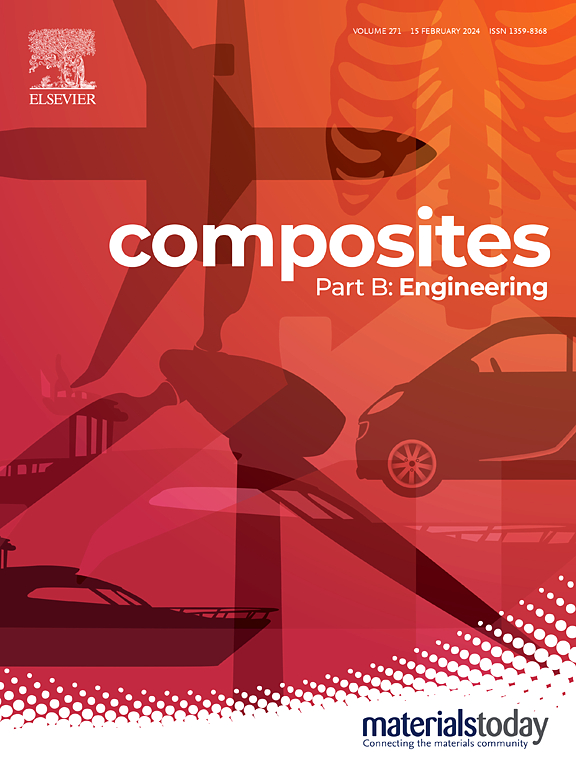通过控制变量实验多维度评价碳纤维增强航空环氧树脂的磷氧化态及加载对其防火安全性的影响
IF 12.7
1区 材料科学
Q1 ENGINEERING, MULTIDISCIPLINARY
引用次数: 0
摘要
了解阻燃剂的多个变量如何影响其复合材料的火灾危险性,对于量化客舱材料和整个飞机的火灾危险性至关重要。为了满足航空应用中日益发展的环氧树脂碳纤维复合材料(EP/CF)严格的防火安全标准,通常需要加入阻燃剂。本工作通过无水哌嗪与二苯酰氯取代反应合成了一种新型阻燃剂PDDO,该阻燃剂具有重叠热解特性,峰值热解温度偏差为7.42%,对应的EP/CF复合材料的峰值热解温度偏差为6.02%。在EP/CF中仅加入5 wt%的PDDO就可以达到UL-94的V-0额定值和54%的LOI,超过了引入11 wt% RDP的额定值。与25 kW/m2的纯EP相比,EP/CF-RDP的峰值放热量和总放热量分别降低了74.38%和72.41%,EP/CF-PDDO的峰值放热量和总放热量分别降低了77.78%和73.93%。EP/CF- rdp和EP/CF- pddo的烟密度低于纯EP,但由于阻燃剂的附加气相效应,分别比EP/CF提高了59.36%和15.50%。建立了多维主客观结合模型,EP/CF-RDP和EP/CF-PDDO的火灾危险性评价值分别比纯EP降低了60.66%和63.17%。本研究阐明了阻燃剂的磷价态、添加剂含量和热稳定性对复合材料火灾危险性的综合影响,为航空材料阻燃剂的选择和火灾危险性评价提供了依据。本文章由计算机程序翻译,如有差异,请以英文原文为准。
Multi-dimensional evaluation of phosphorus oxidation state and loading effects on the fire safety of carbon fiber reinforced aviation epoxy resin via control variables experiment
Understanding how multiple variables of flame retardants affect the fire hazards of their composites is essential for quantifying fire risks of cabin materials and aircraft overall. Incorporating flame retardants is typically required to meet stringent fire safety standards of booming epoxy resin carbon fiber composites (EP/CF) for aviation applications. This work synthesizes a new flame retardant PDDO through a substitution reaction between anhydrous piperazine and diphenylphosphoryl chloride, which has an overlapping pyrolysis characteristic with a deviation of 7.42 % in peak pyrolysis temperature, and that of corresponding EP/CF composites is 6.02 %. Incorporating only 5 wt% PDDO into EP/CF reaches a V-0 rating in the UL-94 and 54 % of LOI, exceeding that of introducing 11 wt% RDP. In comparison to neat EP at 25 kW/m2, the peak heat release and total heat release of EP/CF-RDP are separately reduced by 74.38 % and 72.41 %, while EP/CF-PDDO shows reductions of 77.78 % and 73.93 %, respectively. The smoke density of EP/CF-RDP and EP/CF-PDDO is lower than that of neat EP, but they are separately increased by 59.36 % and 15.50 % compared to EP/CF due to the additional gas-phase effects caused by the flame retardants. A multi-dimensional and subject-objective combined model is established, the evaluation of fire hazard value of EP/CF-RDP and EP/CF-PDDO separately decreases by 60.66 % and 63.17 % compared to neat EP. This study elucidates the combined impact of phosphorus valence state, additive content and thermal stability of flame retardant on the fire hazard of composites, providing a foundation for flame retardant selection and fire hazard assessment for aircraft materials.
求助全文
通过发布文献求助,成功后即可免费获取论文全文。
去求助
来源期刊

Composites Part B: Engineering
工程技术-材料科学:复合
CiteScore
24.40
自引率
11.50%
发文量
784
审稿时长
21 days
期刊介绍:
Composites Part B: Engineering is a journal that publishes impactful research of high quality on composite materials. This research is supported by fundamental mechanics and materials science and engineering approaches. The targeted research can cover a wide range of length scales, ranging from nano to micro and meso, and even to the full product and structure level. The journal specifically focuses on engineering applications that involve high performance composites. These applications can range from low volume and high cost to high volume and low cost composite development.
The main goal of the journal is to provide a platform for the prompt publication of original and high quality research. The emphasis is on design, development, modeling, validation, and manufacturing of engineering details and concepts. The journal welcomes both basic research papers and proposals for review articles. Authors are encouraged to address challenges across various application areas. These areas include, but are not limited to, aerospace, automotive, and other surface transportation. The journal also covers energy-related applications, with a focus on renewable energy. Other application areas include infrastructure, off-shore and maritime projects, health care technology, and recreational products.
 求助内容:
求助内容: 应助结果提醒方式:
应助结果提醒方式:


